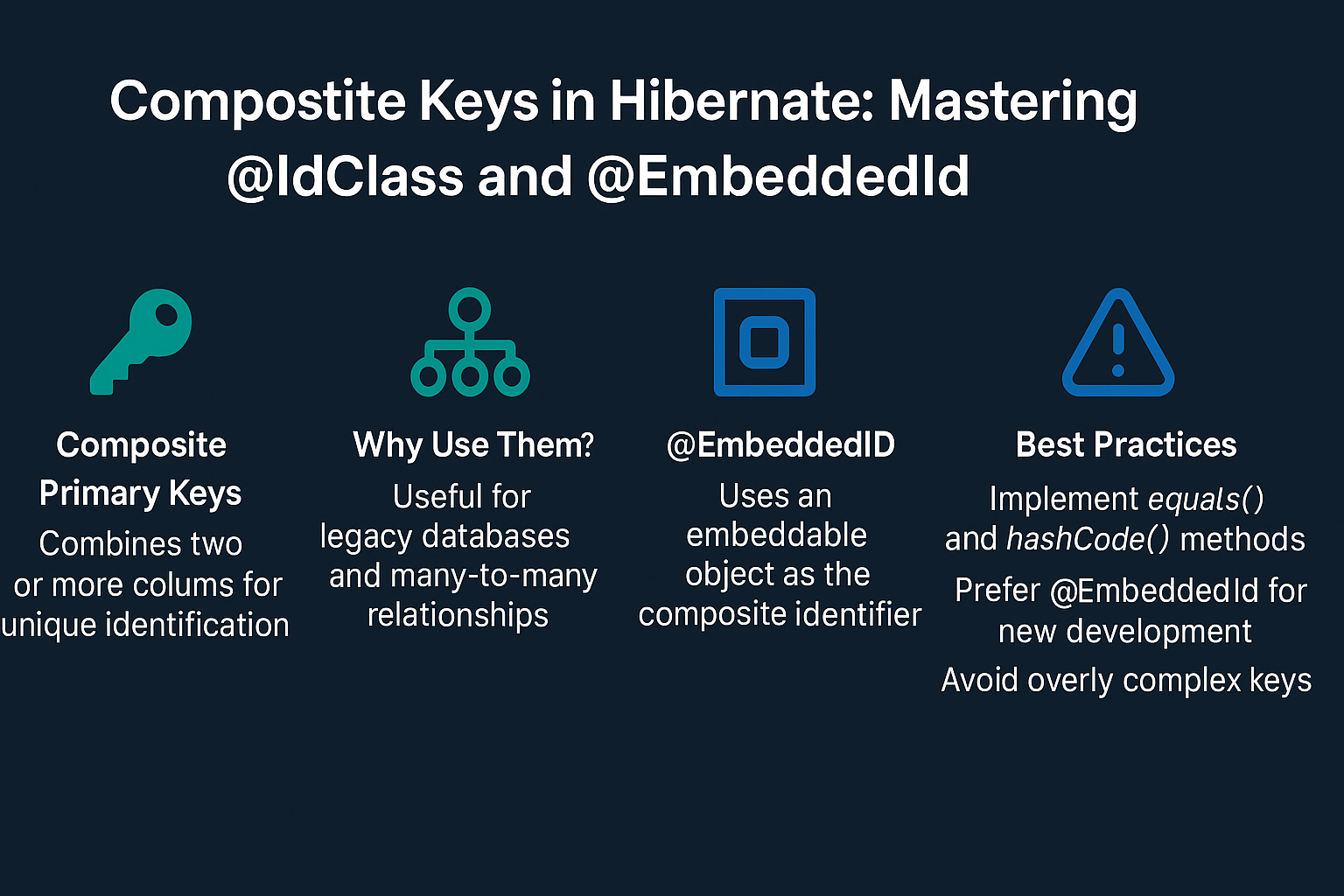In relational databases, tables often require composite primary keys — a combination of two or more columns that uniquely identify a record. For example, an OrderItem table may use both order_id and product_id as identifiers because neither field alone ensures uniqueness.
In Hibernate, composite keys can be implemented using two approaches: @IdClass and @EmbeddedId. Understanding these strategies is crucial for mapping legacy databases, handling complex domain models, and ensuring robust data integrity.
This guide covers both techniques in depth, with real-world examples, code snippets, Hibernate configuration, pitfalls, and best practices.
Core Concepts of Composite Keys
- Composite Key: A primary key made up of multiple fields.
- Why use it?
- Legacy databases often rely on composite keys.
- Ensures uniqueness across multiple columns.
- Essential in many-to-many join tables.
Hibernate provides two standard ways to implement composite keys:
@IdClass— external class that defines the key fields.@EmbeddedId— embeddable object that acts as a composite identifier.
Approach 1: Using @IdClass
Step 1: Create the Composite Key Class
import java.io.Serializable;
import java.util.Objects;
public class OrderItemId implements Serializable {
private Long orderId;
private Long productId;
// Default constructor
public OrderItemId() {}
public OrderItemId(Long orderId, Long productId) {
this.orderId = orderId;
this.productId = productId;
}
// equals and hashCode (important for Hibernate identity management)
@Override
public boolean equals(Object o) {
if (this == o) return true;
if (!(o instanceof OrderItemId)) return false;
OrderItemId that = (OrderItemId) o;
return Objects.equals(orderId, that.orderId) &&
Objects.equals(productId, that.productId);
}
@Override
public int hashCode() {
return Objects.hash(orderId, productId);
}
}
Step 2: Define the Entity with @IdClass
import jakarta.persistence.*;
@Entity
@IdClass(OrderItemId.class)
@Table(name = "order_items")
public class OrderItem {
@Id
private Long orderId;
@Id
private Long productId;
private int quantity;
// Getters and setters
}
Step 3: CRUD Operations
OrderItemId id = new OrderItemId(1L, 101L);
OrderItem item = new OrderItem();
item.setOrderId(1L);
item.setProductId(101L);
item.setQuantity(3);
session.persist(item);
Approach 2: Using @EmbeddedId
Step 1: Create an Embeddable Key Class
import jakarta.persistence.Embeddable;
import java.io.Serializable;
import java.util.Objects;
@Embeddable
public class OrderItemKey implements Serializable {
private Long orderId;
private Long productId;
// Getters, setters, equals, hashCode
}
Step 2: Define the Entity with @EmbeddedId
import jakarta.persistence.*;
@Entity
@Table(name = "order_items")
public class OrderItem {
@EmbeddedId
private OrderItemKey id;
private int quantity;
// Getters and setters
}
Step 3: CRUD Operations
OrderItemKey key = new OrderItemKey();
key.setOrderId(1L);
key.setProductId(101L);
OrderItem item = new OrderItem();
item.setId(key);
item.setQuantity(5);
session.persist(item);
Hibernate Session and Transactions
SessionFactory factory = new Configuration().configure().buildSessionFactory();
Session session = factory.openSession();
Transaction tx = session.beginTransaction();
// Save entity
session.persist(item);
// Fetch entity
OrderItem fetched = session.get(OrderItem.class, key);
tx.commit();
session.close();
Performance Considerations
- Always implement
equals()andhashCode()in key classes to avoid unexpected behavior. @EmbeddedIdis often preferred as it encapsulates the key into a reusable object.- Avoid overly complex composite keys; consider surrogate keys (like auto-increment IDs) when possible.
Real-World Use Cases
- E-commerce:
OrderItem(orderId, productId) - University System:
Enrollment(studentId, courseId) - Banking:
AccountTransaction(accountId, transactionId)
Anti-Patterns and Pitfalls
- Missing
equals()andhashCode()→ leads to duplicate entries in persistence context. - Too many fields in composite key → makes queries and joins inefficient.
- Mixing @Id and @EmbeddedId in the same entity is not recommended.
Best Practices
- Use
@EmbeddedIdfor clarity and encapsulation. - Use
@IdClasswhen working with legacy schemas. - Ensure
equals()andhashCode()are properly implemented. - Keep composite keys small and meaningful.
📌 Hibernate Version Notes
-
Hibernate 5.x:
SessionFactorysetup viaConfiguration.javax.persistencenamespace.
-
Hibernate 6.x:
- Moved to
jakarta.persistencenamespace. - Enhanced query capabilities with SQL support.
- Improved bootstrapping API for better integration with Spring Boot.
- Moved to
Conclusion & Key Takeaways
- Composite keys are essential for real-world database modeling.
- Hibernate supports two approaches:
@IdClassand@EmbeddedId. - Always define proper
equals()andhashCode()methods. - Choose the right strategy depending on your schema and use case.
- For new systems, prefer single surrogate keys (like UUIDs) unless composite keys are necessary.
FAQ
1. What’s the difference between Hibernate and JPA?
Hibernate is an ORM implementation, while JPA is a specification that Hibernate implements.
2. How does Hibernate caching improve performance?
By storing frequently accessed data in memory, reducing database round-trips.
3. What are the drawbacks of eager fetching?
It can load unnecessary data, increasing memory usage and query time.
4. How do I solve the N+1 select problem in Hibernate?
Use JOIN FETCH in HQL or enable batch fetching strategies.
5. Can I use Hibernate without Spring?
Yes, Hibernate can run standalone with its own configuration.
6. What’s the best strategy for inheritance mapping?
Depends on use case: SINGLE_TABLE for performance, JOINED for normalization.
7. How does Hibernate handle composite keys?
Using @IdClass or @EmbeddedId to map multiple fields as a single identifier.
8. How is Hibernate 6 different from Hibernate 5?
Hibernate 6 uses the jakarta.persistence namespace and provides a modern query API.
9. Is Hibernate suitable for microservices?
Yes, but consider lightweight ORMs or JDBC for performance-critical services.
10. When should I not use Hibernate?
Avoid Hibernate in systems requiring ultra-low latency or highly specialized SQL.
